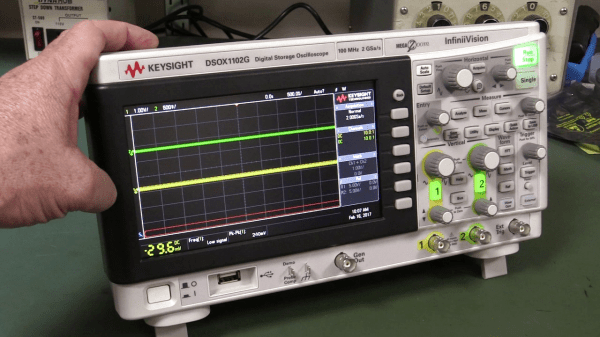It’s not every day that we have the pleasure of being excited about a new oscilloscope in the market; not only is it affordable but also produced by one of the industry’s big players. To top it all off, all the marketing is carefully crafted towards students and hackers.
Keysight recently released a new line of oscilloscopes called the 1000X series that starts at $448. It’s an entry level, two-channel scope having (officially) 50 MHz, 70 MHz and 100 MHz versions to choose from. It hosts their standard technology such as Megazoom, but also some interesting, albeit optional extra quirks such as an in-built signal generator and a simple network analyser with gain and phase plot capability.
The release of this scope and the marketing strategy employed by Keysight feels like they’re late to this entry-level party but still want to get in on the fun. In the words of Keysight we should all immediately “Scrap the toys, get a real oscilloscope” . The persuasion has gone a step further; Keysight has kindly facilitated many giveaways and generated hype from our favorite EE YouTuber’s. If anything, this certainly heats up the entry level scope market, so we at Hackaday welcome it with open arms.
All this fuss about affordable yet capable entry level scopes started with Rigol. Here was a company that actually bothered to genuinely market a scope to the masses at a reasonable price. At the time, the norm for such scopes was to be marketed solely to schools and universities by large teams of suits. Winning the hearts (and money) of any hackers along the way was merely collateral damage. The scope that considerably changed this was the Rigol DS1052e, the predecessor of the DS1054z which is now considered the benchmark for all entry level scopes. If Keysight is to entice us to scrap the toys, the 1000X series must spar with the community’s current sweetheart.
It is still early days for this scope, but [Dave Jones] already received one and successfully unlocked the shipped bandwidth lock. He has even unearthed an undocumented 200 MHz bandwidth mode by hacking the main processor board! Unsurprisingly, the analog front end is consistent across all the models with the sampling rate and bandwidth being set, rather old-fashionedly, by a few resistors on the main processor board.
Continue reading “Keysight’s New 1000-X Scopes Get Double Hertz”














